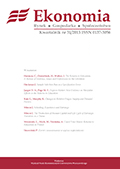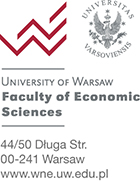Instytucjonalny model strategii korporacyjnych
K. Waśniewski
ABSTRACT:
Full text (PDF)
Issue number: 29
In this issue:
Instytucjonalny model strategii korporacyjnych
K. Waśniewski
ABSTRACT |
PDF
The present paper presents a model of investment decisions made by corporations. The decisions in question are perceived as part of corporate strategies, defined in a behavioural way. The model attempts to integrate the classical microeconomics\’ point of view with that of the new institutional economics, formalizing the resulting assumptions on the grounds of three theories of games: Selten\’s, Harsany\i’s and Nash\’s. Corporate strategies are defined as a set of four games: the capital market game, the corporate governance game, the product markets game and the social responsibility game. The four games are played in parallel and in mutual interaction, each of them being a temporarily normalized sub-game of the Selten\’s extensive game with imperfect recall, and being played as a Harsanyi\’s game with imperfect information and various degrees of cooperation. In each of the four games the presence of Nash\’s dynamic equilibrium, manifested as a critical level of consistency in individual players\’ strategies, is of crucial importance. In presence of Nash\’s dynamic equilibrium, corporations orient their behaviour towards development, technological progress included. In the absence of Nash\’s dynamic equilibrium corporations would orient their strategies exclusively on managing risk.
Zapewnie ciągłości działania — nowe kierunki w zarządzaniu operacyjnym i ochronie reputacji przedsiębiorstw
T. Potocki
ABSTRACT |
PDF
Today\’s enterprises are exposed to number of different systematic risks including natural disasters, frauds or information systems defects. These kind of risks may not only disturb company\’s operational activity but in extreme situations completely destroy reputation or lead to bankruptcy. Business continuity management is a process of uncertainty management, which supports restoring operational continuity and as a consequence protecting reputation. The goal of his paper is to propose BCM as an organizational tool and strategic framework within the context of reputation protection.
Wydatkowa sfera polskich finansów publicznych w 2010 roku. Kierunki reform sektora
P. Kolanowski
ABSTRACT |
PDF
Strength of country depends on its public\’s finance condition. Recentlymost of European\’s governments had a problem with the budget and the public debt. The same circumstances were in Polish public finance. In 2010 expenditures exceeded incomes, value of the budget deficit was about 45 billion zlotys. In compliance with ESA 95 standard the general government deficit reach almost 111.5 billion zlotys. That situation had impact to the public debt which amount 748.5 billion (the general government debt amount 778.2 billion zlotys). Although Poland had met convergence criterion, the public finance need reforms. In the article were presented three solutions. First of all, expenditures connected with the public administration and government consumption should be reduced. Secondly, reasonable cuts of benefits, especially unemployment benefits and groundless benefits, could bring savings which will be transferred to institution thatmanage the vocational activation. In the third place, the pension system needs intense reforms. System should be standardize and all of privileges have to be eliminated. Those solutions would be the beginning of greater changes.
Specyfika agroturystyki Polski na tle wybranych krajów Unii Europejskiej
I. Marzejon-Frycz
ABSTRACT |
PDF
Agritourism is one of the most important directions of tourism activities as well as an important element of economic development of rural areas. This article attempts to analyze Polish agritourism development in the context of chosen European countries. This paper examines the historical basis of agritourism development, spatial distribution of agritouristic accommodation, farms offer, associations of rural tourism activities and the impact of local and national policy on development of this form of tourism. This analysis allows to insert the thesis that agritourism in Poland in many ways is on the same level as it was in Western European countries a dozen years ago. Despite of that, Polish agritourism has all to be able to catch up with western pattern in short period of time. The summary of the analysis is regionalization of Poland for opportunities of agritourism development in nearest future.
Nowa marka miejska: jej kreacja i społeczna recepcja. Przykład Metropolii „Silesia”
A. Wycisk
ABSTRACT |
PDF
The article presents the most important results of sociological research conducted in 2011 in 14 cities of the “Silesia” Metropolis (Górnośląsko-Zagłębiowska Metropolia “Silesia”). The study formed the basis of a thesis written under the supervision of professor Marek S. Szczepanski, defended at the Institute of Sociology at the University of Silesia in Katowice. The thesis won the ministry of regional development award in the competition “Teraz Polska Promocja 2011”. Themain focus of research is an analysis of the social reception of a new urban brand (“Silesia” Metropolis) in less than a year after the introduction of the corporate identity and launching the informative campaign. The study including questions on corporate identity, sympathy towards the new brand is followed by an in-depth analysis of plethora of themes, especially socio-cultural, political and economic background. Presented sociological studies are qualitative (expert interview) and quantitative (survey).
To answer or not to answer? A field test of loss aversion
M. Krawczyk
ABSTRACT |
PDF
This study is a field experiment on loss aversion. The framing of scoring rules was differentiated in an exam at the University of Warsaw, with only half the students facing explicit penalty points in the case of giving an incorrect answer. Loss aversion predicts that less risk will be taken (less questions will be answered) when losses are possible but in fact, no treatment effect was observed.
Simple is better. Empirical comparison of American option valuation methods
K. Toporek
ABSTRACT |
PDF
Technique for American options valuation, combining Least Squares Monte Carlo with Duan\’s model under the assumption that the volatility of the underlier can be described by GARCH(1, 1) process, has been confronted with simple binomial tree model. Results of comparison of model outcomes with market prices for ten different CBOE-traded stock options indicate that simple binomial model is superior to sophisticated GARCH-LSM method. The results hold regardless of option characteristics—“moneyness” ratio and time to maturity. Incorporating dividend in binomial model does not significantly alter the valuation outcomes. Detailed analysis shows also that for each of the methods pricing errors grow as the “moneyness” ratio decreases.

